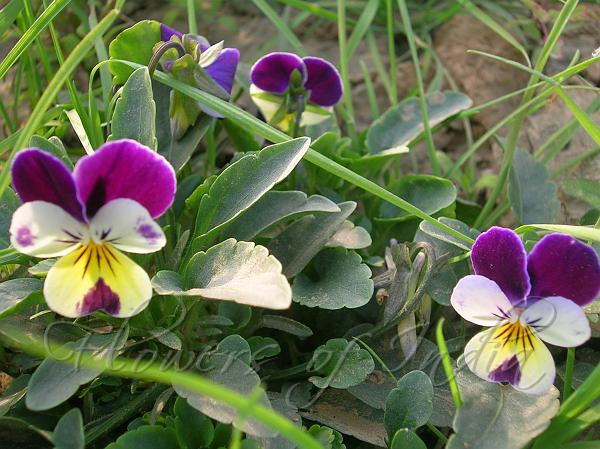|
| Heart's Ease |
|

|

| File size | 1042938 |
| Original date | 1/19/08 4:09 PM |
| Resolution | 2048 x 1536 |
| Flash | Flash did not fire, auto |
| Focal length | 8.0mm |
| Exposure time | 1/115s |
| Aperture | 3.2 |
| Focus Distance | |
| Metering Mode | Partial |
| Camera make | NIKON |
| Camera model | E3700 |
| Sensor type |
|
|
|
|
Photo: |
Botanical name: Viola tricolor Family: Violaceae (Violet family)
Synonyms: Jacea tricolor, Viola luteola, Viola nemausensis
Synonyms: Jacea tricolor, Viola luteola, Viola nemausensis
The Heartsease is as variable as any of the other
members of the genus, but whatever modifications of form it may
present, it may always be readily distinguished from the other Violets
by the general form of its foliage, which is much more cut up than in
any of the other species and by the very large leafy stipules at the
base of the true leaves. Besides the free branching of the stem, which
is mostly 4 to 8 inches in height, it is generally very angular. The
leaves are cut into rounded lobes, the terminal one being considerably
the largest. The flowers are 0.6-3 cm across, vary a great deal in
colour and size, but are either purple, yellow or white, and most
commonly there is a combination of all these colours in each blossom.
The upper petals are generally most showy in colour and purple in tint,
while the lowest and broadest petal is usually a more or less deep tint
of yellow. The base of the lowest petal is elongated into a spur, as in
the Violet. The flowers are followed by the little seed-pods, which
when ripe, open by three valves. Darwin found that the humble bee was
the commonest insect visitor of the Heartsease, Heart's Ease is a very
common garden plant.
Medicinal uses: It was formerly in much repute
as a remedy for epilepsy, asthma and numerous other complaints, and the
flowers were considered cordial and good in diseases of the heart, from
which may have arisen its popular name of Heartsease as much as from
belief in it as a love potion. A strong decoction of syrup of the herb
and flowers was recommended by the older herbalists for skin diseases
and a homoeopathic medicinal tincture is still made from it with
spirits of wine, using the entire plant, and given in small diluted
doses for the cure of cutaneous eruptions.
It was formerly in much repute
as a remedy for epilepsy, asthma and numerous other complaints, and the
flowers were considered cordial and good in diseases of the heart, from
which may have arisen its popular name of Heartsease as much as from
belief in it as a love potion. A strong decoction of syrup of the herb
and flowers was recommended by the older herbalists for skin diseases
and a homoeopathic medicinal tincture is still made from it with
spirits of wine, using the entire plant, and given in small diluted
doses for the cure of cutaneous eruptions.
Medicinal uses:
 It was formerly in much repute
as a remedy for epilepsy, asthma and numerous other complaints, and the
flowers were considered cordial and good in diseases of the heart, from
which may have arisen its popular name of Heartsease as much as from
belief in it as a love potion. A strong decoction of syrup of the herb
and flowers was recommended by the older herbalists for skin diseases
and a homoeopathic medicinal tincture is still made from it with
spirits of wine, using the entire plant, and given in small diluted
doses for the cure of cutaneous eruptions.
It was formerly in much repute
as a remedy for epilepsy, asthma and numerous other complaints, and the
flowers were considered cordial and good in diseases of the heart, from
which may have arisen its popular name of Heartsease as much as from
belief in it as a love potion. A strong decoction of syrup of the herb
and flowers was recommended by the older herbalists for skin diseases
and a homoeopathic medicinal tincture is still made from it with
spirits of wine, using the entire plant, and given in small diluted
doses for the cure of cutaneous eruptions. | Identification credit: Tabish | Photographed in Delhi. |
• Is this flower misidentified? If yes,